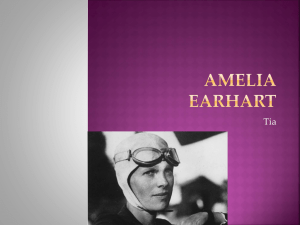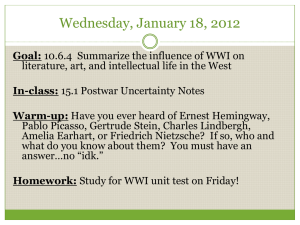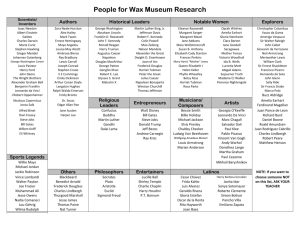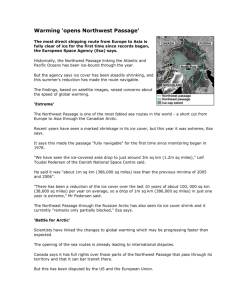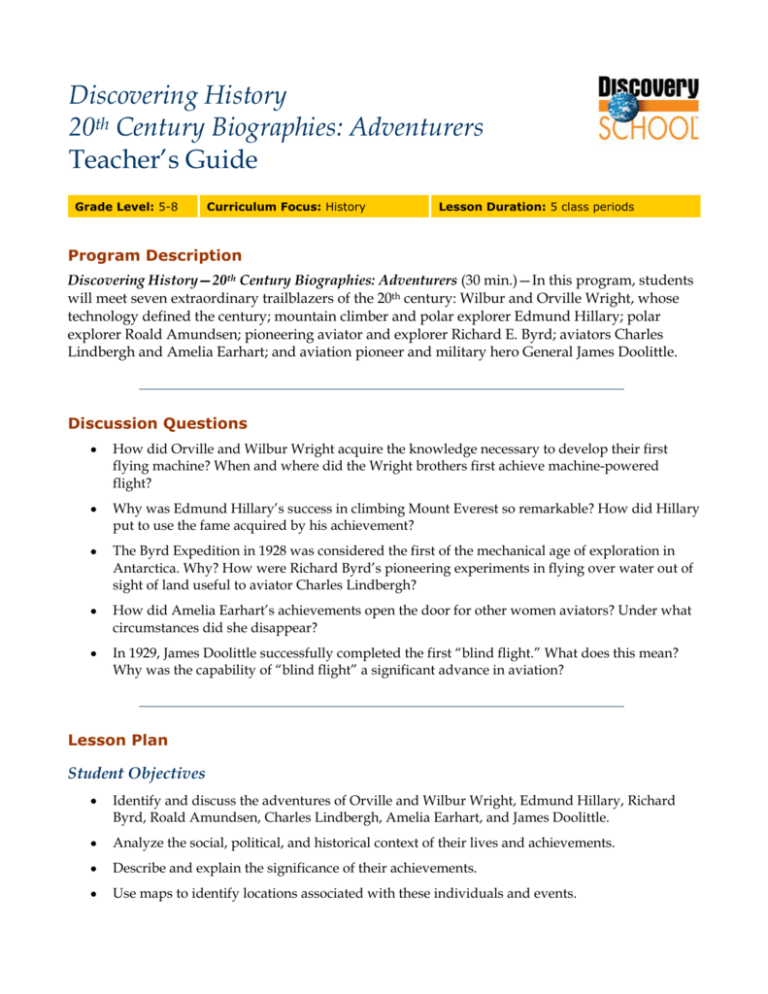
Discovering History
20th Century Biographies: Adventurers
Teacher’s Guide
Grade Level: 5-8
Curriculum Focus: History
Lesson Duration: 5 class periods
Program Description
Discovering History—20th Century Biographies: Adventurers (30 min.)—In this program, students
will meet seven extraordinary trailblazers of the 20th century: Wilbur and Orville Wright, whose
technology defined the century; mountain climber and polar explorer Edmund Hillary; polar
explorer Roald Amundsen; pioneering aviator and explorer Richard E. Byrd; aviators Charles
Lindbergh and Amelia Earhart; and aviation pioneer and military hero General James Doolittle.
Discussion Questions
•
How did Orville and Wilbur Wright acquire the knowledge necessary to develop their first
flying machine? When and where did the Wright brothers first achieve machine-powered
flight?
•
Why was Edmund Hillary’s success in climbing Mount Everest so remarkable? How did Hillary
put to use the fame acquired by his achievement?
•
The Byrd Expedition in 1928 was considered the first of the mechanical age of exploration in
Antarctica. Why? How were Richard Byrd’s pioneering experiments in flying over water out of
sight of land useful to aviator Charles Lindbergh?
•
How did Amelia Earhart’s achievements open the door for other women aviators? Under what
circumstances did she disappear?
•
In 1929, James Doolittle successfully completed the first “blind flight.” What does this mean?
Why was the capability of “blind flight” a significant advance in aviation?
Lesson Plan
Student Objectives
•
Identify and discuss the adventures of Orville and Wilbur Wright, Edmund Hillary, Richard
Byrd, Roald Amundsen, Charles Lindbergh, Amelia Earhart, and James Doolittle.
•
Analyze the social, political, and historical context of their lives and achievements.
•
Describe and explain the significance of their achievements.
•
Use maps to identify locations associated with these individuals and events.
Discovering History
20th Century Biographies: Adventurers
Teacher’s Guide
•
Select one adventurer and write a fictional letter or journal entry expressing the individual’s
personal reaction to a specific event or achievement.
•
Research and present an oral report on the life and legacy of a significant female explorer or
aviator such as Amelia Earhart.
2
Materials
•
Discovering History—20th Century Biographies: Adventurers video
•
Computer with Internet access
•
Large world map
•
Print resources about Orville and Wilbur Wright, Edmund Hillary, Richard Byrd, Roald
Amundsen, Charles Lindbergh, Amelia Earhart, and James Doolittle
•
Print resources on women adventurers in the fields of exploration and aviation
•
Print resources on the history of the Northwest Passage and current changes in the passage due
to global warming
Procedures
1. Prior to viewing the program, ask students to define and provide examples of an “adventurer.”
Help them generate a list of words that describe the personal qualities and characteristics of an
adventurer. On the board, print the names of the individuals presented in this program: Orville
and Wilbur Wright, Edmund Hillary, Richard Byrd, Roald Amundsen, Charles Lindbergh,
Amelia Earhart, and James Doolittle. Explain to students that they will be viewing a program
about these trailblazers, and ask them to share what they know about each. Encourage students
to keep the following questions in mind as they watch the program: What were the significant
contributions of each adventurer? What specific personal qualities or characteristics did each
demonstrate that could be linked to his or her success? (You may also wish to refer to the
vocabulary section of this guide and discuss any terms with which students are unfamiliar.)
2. After viewing the program, review the information presented: Who were the men and women
presented in the program? (List responses on the board.) What were the key achievements of
each? (List responses.) What permanent changes resulted from each of these achievements?
What significance do their achievements have in our lives today? Which of the adventurers
relied on the airplane in order to achieve his or her goal? Which goal(s) could have been
attained without the airplane?
3. Map work: Ask students to locate the following places on a large world map: Ohio; Kittyhawk,
North Carolina; Arctic region; Antarctica; the Himalayas; Nepal; New Zealand; the Northwest
Passage; Howland Island (an unincorporated territory of the United States located between
Hawaii and Australia); Pearl Harbor, Hawaii; New York City, New York; Paris, France; Japan.
Discuss the importance of each location in relation to the people and events presented in the
program.
Published by Discovery Education. © 2005. All rights reserved.
Discovering History
20th Century Biographies: Adventurers
Teacher’s Guide
3
4. Discussion: In this program, six of the seven adventurers featured are men. Yet women have
made significant contributions to the fields of exploration and aviation. Discuss the following:
What characteristics would male and female adventurers have in common? How might they be
different? Why is it important to recognize the hard work and success of others no matter the
gender (or race) of the achiever?
5. Assign students to research the topic of female explorers and aviators, select an individual for
further research, and prepare a report based on their research findings. Have students share
their reports with the rest of the class in an oral presentation. Encourage them to enhance their
reports with visuals. The following Web sites provide relevant research information:
•
Women Adventurers
www.infoplease.com/spot/whmbios13.html
•
You Go Girl: 7 Women Explorers
http://ca.encarta.msn.com/list_yougogirl/you_go_girl_7_women_explorers.html
•
Early Women Aviators
www.pbs.org/wgbh/amex/flygirls/peopleevents
•
The Ninety-Nines: Women in Aviation
www.ninety-nines.org/bios.html
6. Short essay topic: Discuss Edmond Hillary’s statement, “It is not the mountain we conquer, but
ourselves.” To what accomplishment was he referring? What do you think he meant? In a larger
sense, how might this statement be applied to obstacles and achievements in life? Assign
students to write a short essay that answers the following question: How might you apply
Edmund Hillary’s philosophy to your personal dreams and goals?
7. The Northwest Passage, Then and Now: During the 16th century, European powers began to
investigate the possibility of a passage in the Northwest that would offer a sea route to the
Orient. Nearly all expeditions failed; some ended in death. Using print and Web resources, have
students research this topic in preparation for a general class discussion of the Northwest
Passage, past and present: Where is the Northwest Passage? Who was seeking it? Why? Why
was navigating the passage so difficult and dangerous? How did the search for the passage
advance exploration of North America? When did humans first traverse the passage? Who were
the people that traveled through it? What changes in the ice cover are taking place currently?
What are the possible benefits of these changes? What effects will these changes have on the
lives of the indigenous people and wildlife? The following Web sites provide relevant
information:
•
Northwest Passage
http://en.wikipedia.org/wiki/northwest_passage
•
Northwest Passage (links page for students)
www.athropolis.com/links/nwpass.htm
•
Will ice melt open fabled Northwest Passage?
http://archives.cnn.com/2002/tech/science/08/29/northwest.passage
Published by Discovery Education. © 2005. All rights reserved.
Discovering History
20th Century Biographies: Adventurers
Teacher’s Guide
•
4
Arctic Net (archives): Arctic melt may open up Northwest Passage
www.arcticnetulaval.ca/index.php?fa=news.shownews&home=4&menu=55&sub=1&id=2
8. Extra Credit: Have students select one of the following topics for additional research and an
oral report. Topics include the early history of flight (pre-Wright Brothers); Edmund Hillary’s
1960 Silver Hut Physiological Expedition in search of the mythical Yeti; the development and
early uses of dirigibles; the mystery of Amelia Earhart’s disappearance; kidnapping of the
Lindbergh baby; Admiral Byrd and the post-WWII U.S. government expedition Operation
Highjump; the Doolittle Raid and its outcome; or the great “Amundsen versus Scott” race to the
South Pole.
9. Creative writing: Have students select one adventurer presented in the program and one key
event or achievement in that person’s life. Assign students to write a fictional letter or journal
entry expressing the selected individual’s personal reaction to the event or achievement. Have
students share their completed letter or journal entry with the rest of the class.
Assessment
Use the following three-point rubric to evaluate students' work during this lesson.
•
3 points: Students clearly demonstrated ability to effectively participate in class discussions,
conducting all requested research in preparation; produced a complete oral report on a
woman aviator/explorer, including all of the required information; created a well-written,
fact-based, and thoughtful letter/journal entry.
•
2 points: Students demonstrated ability to participate in class discussions, conducting
adequate research in preparation; produced an adequate oral report on a woman
aviator/explorer, including most of the required information; created a satisfactory
letter/journal entry.
•
1 point: Students demonstrated minimal ability to participate in class discussions; created an
incomplete oral report on a woman aviator/explorer, with little or none of the required
information; did not create a satisfactory letter/journal entry.
Vocabulary
adventurer
Definition: An individual in search of adventure; somebody who enjoys exciting or risky
activities
Context: Adventurers such as Edmund Hillary or Amelia Earhart helped expand the boundaries
of human understanding and capabilities.
aviator
Definition: Someone who flies an aircraft; pilot
Context: Charles Lindbergh was the first aviator to complete a solo nonstop transatlantic flight.
Published by Discovery Education. © 2005. All rights reserved.
Discovering History
20th Century Biographies: Adventurers
Teacher’s Guide
5
barnstorming
Definition: A popular form of entertainment in the 1920s in which stunt pilots would perform
tricks with airplanes, often in groups
Context: Barnstorming pilot Frank Hawks took Amelia Earhart on her first airplane ride.
dirigible
Definition: An airship; a lighter-than-air aircraft that can be steered and propelled
Context: Roald Amundsen made the first trans-Arctic flight across the North Pole on the
dirigible Norge.
expedition
Definition: An organized trip by a group; a trip made by a group of people for a particular
purpose, e.g. to explore unknown territory, to conduct a scientific study, or to achieve a military
objective
Context: Edmund Hillary was one of the chief climbers in the 1953 British Mount Everest
Expedition.
Himalayas
Definition: A mountain range extending 1,500 miles on the border between India and Tibet
Context: The Himalayas form the Earth’s highest mountain region, containing nine of the ten
highest peaks in the world.
monoplane
Definition: An airplane that has one pair of wings
Context: Charles Lindbergh completed his famous transatlantic flight in a monoplane called
Spirit of St. Louis.
Northwest Passage
Definition: A water route between the Atlantic and the Pacific Oceans along the northern coast
of North America
Context: When Roald Amundsen successfully traversed the Northwest Passage in the early 20th
century, his achievement ended a search that had begun in 16th century Europe.
Sherpa
Definition: A member of the Himalayan people living in Nepal and Tibet who are famous for
their skill as mountaineers
Context: Sherpa guide, Tenzing Norgay, accompanied Edmund Hillary to the summit of Mount
Everest.
Published by Discovery Education. © 2005. All rights reserved.
Discovering History
20th Century Biographies: Adventurers
Teacher’s Guide
6
scientific method
Definition: A method of investigation involving observation and theory to test scientific
hypotheses
Context: Wilbur and Orville Wright applied the scientific method to their development of the
first machine-powered airplane to carry a human pilot.
transatlantic
Definition: Relating to or engaged in crossing the Atlantic
Context: One year after Lindbergh’s New York-to-Paris flight, Amelia Earhart became the first
woman to complete a solo transatlantic flight.
wing warping
Definition: An early system to control the roll of an airplane in flight
Context: The wing warping system employed by Orville and Wilbur Wright used pulleys and
cables to twist the trailing edges of the wings in opposite directions.
Academic Standards
Mid-continent Research for Education and Learning (McREL)
McREL's Content Knowledge: A Compendium of Standards and Benchmarks for K–12 Education
addresses 14 content areas. To view the standards and benchmarks, visit
http://www.mcrel.org/compendium/browse.asp
This lesson plan addresses the following national standards:
•
History—Historical Understanding: Understands and knows how to analyze chronological
relationships and patterns; Understands the historical perspective
•
United States History: Era 7—The Emergence of Modern America (1890–1930)—
Understands how the United States changed between the post-World War I years and the
eve of the Great Depression
•
United States History: Era 8—The Great Depression and World War II (1929–1945)—
Understands the causes and course of World War II, the character of the war at home and
abroad, and its reshaping of the U.S. role in world affairs
•
World History: Era 8—A Half-Century of Crisis and Achievement, 1900–1945—Understands
the causes and global consequences of World War II; Understands major global trends from
1900 to the end of World War II
•
World History Across the Eras: Understands long-term changes and recurring patterns in
world history
•
Science: Nature of Science—Understands the nature of scientific knowledge; Understands
the nature of scientific inquiry; Understands the scientific enterprise
Published by Discovery Education. © 2005. All rights reserved.
Discovering History
20th Century Biographies: Adventurers
Teacher’s Guide
7
•
Technology—Understands the relationships among science, technology, society, and the
individual; Understands the nature of technological design; Understands the nature and
operation of systems; Understands the nature and uses of different forms of technology
•
Geography: The World in Spatial Terms—Knows the location of places, geographic features,
and patterns of the environment
The National Council for the Social Studies (NCSS)
NCSS has developed national guidelines for teaching social studies. To become a member of NCSS,
or to view the standards online, go to http://www.socialstudies.org
This lesson plan addresses the following thematic standards:
•
Culture
•
Time, Continuity, and Change
•
People, Places, and Environments
•
Science, Technology, and Society
•
Global Connections
Support Materials
Develop custom worksheets, educational puzzles, online quizzes, and more with the free teaching tools
offered on the DiscoverySchool.com Web site. Create and print support materials, or save them to a
Custom Classroom account for future use. To learn more, visit
•
http://school.discovery.com/teachingtools/teachingtools.html
Credit
Patricia A. Peirson, freelance writer; former elementary school and adult ESL educator
Published by Discovery Education. © 2005. All rights reserved.

